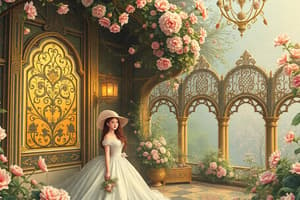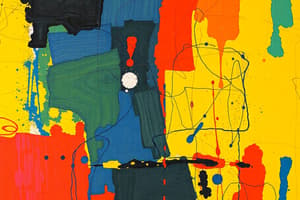Podcast
Questions and Answers
Which of the following is NOT a type of visual art?
Which of the following is NOT a type of visual art?
- Digital Art
- Sculpture
- Photography
- Dance (correct)
What best describes the purpose of applied arts?
What best describes the purpose of applied arts?
- To enhance functionality and aesthetics of everyday objects (correct)
- To create works for performance
- To communicate cultural values through storytelling
- To critique and interpret existing artworks
Which aspect of arts is primarily concerned with the study of beauty and taste?
Which aspect of arts is primarily concerned with the study of beauty and taste?
- Style
- Medium
- Aesthetics (correct)
- Art Criticism
Which performing art is characterized by dramatic performances?
Which performing art is characterized by dramatic performances?
Which genre does NOT belong to literary arts?
Which genre does NOT belong to literary arts?
How can arts contribute to economic growth?
How can arts contribute to economic growth?
What best describes the characteristics of contemporary arts?
What best describes the characteristics of contemporary arts?
What role does arts play in community engagement?
What role does arts play in community engagement?
Flashcards are hidden until you start studying
Study Notes
Definition of Arts
- Broad Concept: Encompasses various forms of creative expression.
- Categories: Visual arts, performing arts, literary arts, and applied arts.
Visual Arts
- Types:
- Painting: Use of pigments on surfaces (canvas, paper).
- Sculpture: Three-dimensional art created from materials like stone, metal, or clay.
- Photography: Capturing images using cameras.
- Printmaking: Creating artworks through printing techniques.
- Digital Art: Art created or manipulated digitally.
Performing Arts
- Forms:
- Theatre: Dramatic performances, including plays and musicals.
- Dance: Movement expression, including ballet, modern dance, and folk dance.
- Music: Art form combining sounds; includes various genres (classical, jazz, pop, etc.).
- Performance Art: Combines multiple disciplines, often interactive and conceptual.
Literary Arts
- Genres:
- Fiction: Novels, short stories; imaginative narratives.
- Poetry: Expressive language, often employing rhythm and metaphor.
- Drama: Written works intended for performance.
- Non-Fiction: Informative texts based on facts.
Applied Arts
- Definition: Design and aesthetics applied to everyday objects.
- Examples:
- Graphic Design: Visual content creation for communication.
- Fashion Design: Creation of clothing and accessories.
- Industrial Design: Design of products for manufacturing.
Importance of Arts
- Cultural Reflection: Mirrors society’s values, beliefs, and experiences.
- Emotional Expression: Provides a medium for expressing feelings and ideas.
- Cognitive Development: Enhances critical thinking, creativity, and problem-solving skills.
- Community Engagement: Fosters collaboration and connections among individuals.
Influence of Arts
- Historical Impact: Shapes and records cultural history.
- Social Change: Can challenge norms and inspire movements.
- Economic Contribution: Generates jobs and boosts local economies through tourism and events.
Key Concepts in Arts
- Aesthetics: Study of beauty and taste in art.
- Art Criticism: Evaluation and interpretation of art.
- Medium: Material or technique used to create an artwork.
- Style: Distinctive manner in which an artist expresses their vision.
Contemporary Arts
- Trends: Increasing use of technology, multimedia, and interdisciplinary approaches.
- Social Practice: Art that engages with community and social issues.
- Globalization: Diverse influences due to cross-cultural exchange and collaboration.
Definition of Arts
- Encompasses a wide range of creative expressions across various forms.
- Main categories include visual arts, performing arts, literary arts, and applied arts.
Visual Arts
- Painting: Involves using pigments on surfaces such as canvas and paper.
- Sculpture: Three-dimensional artworks made from materials like stone, metal, or clay.
- Photography: The art of capturing images through the use of cameras.
- Printmaking: Produces artworks by applying printing techniques.
- Digital Art: Artworks created or manipulated using digital tools.
Performing Arts
- Theatre: Involves dramatic performances, including various types like plays and musicals.
- Dance: Artistic expression through human movement, covering styles such as ballet and modern dance.
- Music: Combines sounds into art forms, spanning multiple genres including classical and jazz.
- Performance Art: An interdisciplinary approach that often blends different art forms in an interactive manner.
Literary Arts
- Fiction: Creative narratives presented in novels and short stories.
- Poetry: Literary form employing expressive language often featuring rhythm and metaphor.
- Drama: Texts composed for performance, generally characterized by dialogue.
- Non-Fiction: Informational writing grounded in factual content.
Applied Arts
- Utilizes design and aesthetics to enhance everyday objects and experiences.
- Graphic Design: Involves creating visual content for effective communication.
- Fashion Design: Focused on the creation of garments and accessories.
- Industrial Design: Centers on product design for mass production.
Importance of Arts
- Serves as a reflection of cultural values, beliefs, and experiences.
- Facilitates emotional expression, providing a medium for conveying feelings and ideas.
- Promotes cognitive development through enhancing critical thinking, creativity, and problem-solving abilities.
- Encourages community engagement by fostering collaboration and connections among individuals.
Influence of Arts
- Plays a critical role in shaping and recording cultural history.
- Acts as a catalyst for social change, challenging norms and inspiring movements.
- Contributes economically by generating jobs and boosting local economies through tourism and artistic events.
Key Concepts in Arts
- Aesthetics: Deals with the nature of beauty and taste as they relate to art.
- Art Criticism: Involves evaluating and interpreting artworks for understanding and appreciation.
- Medium: Refers to the materials or techniques employed in creating an artwork.
- Style: The unique manner in which an artist conveys their perspective and vision.
Contemporary Arts
- Trends: Notable increase in the integration of technology and multimedia in art creation.
- Social Practice: Artistic endeavors that actively engage with community issues and social matters.
- Globalization: Emphasizes the impact of diverse cultural influences through cross-cultural exchanges and collaborations.
Studying That Suits You
Use AI to generate personalized quizzes and flashcards to suit your learning preferences.




